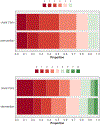DASH-HF Study: A Pragmatic Quality Improvement Randomized Implementation Trial for Patients With Heart Failure With Reduced Ejection Fraction
- PMID: 37494051
- PMCID: PMC10524378
- DOI: 10.1161/CIRCHEARTFAILURE.122.010278
DASH-HF Study: A Pragmatic Quality Improvement Randomized Implementation Trial for Patients With Heart Failure With Reduced Ejection Fraction
Abstract
Background: Heart failure is a prevailing diagnosis of hospitalization and readmission within 6 months, and nearly a quarter of these patients die within a year. Guideline-directed medication therapies reduce risk of mortality by 73% over 2 years; however, the implementation of these therapies to their target dose in clinical practice continues to be challenging. In 2020, the Veterans Affairs (VA) Health Care System developed a HF dashboard to monitor and improve outpatient HF management. The DASH-HF (Dashboard Activated Services and Telehealth for Heart Failure) study is a randomized, pragmatic clinical trial to evaluate proactive dashboard-directed telehealth clinics to improve the use and dosing of guideline-directed medication therapy for patients with heart failure with reduced ejection fraction not on optimal guideline-directed medication therapy within the VA.
Methods: Three hundred veterans with heart failure with reduced ejection fraction met inclusion criteria with an optimization potential score (OPS) of 5 or less out of 10, representing nonoptimal guideline-directed medication therapy. The primary outcome was a composite score of guideline-directed medical therapy, the OPS, 6 months after the end of the intervention. Secondary outcomes included active prescriptions for each individual guideline-directed medical therapy class, HF-related hospitalizations, deaths, and clinician time per patient during the intervention clinics.
Results: There was no significant difference between the intervention arm and usual care group in the primary outcome (OPS, 2.9; SD=2.1 versus OPS, 2.6, SD=2.1); adjusted mean difference 0.3 (95% CI, -0.1 to 0.7) or in the prespecified secondary outcomes for hospitalization and all-cause mortality for the intervention of proactive dashboard-based clinics.
Conclusions: A dashboard-based clinic intervention did not improve the OPS or secondary outcomes of hospitalization and all-cause mortality. There remains a larger opportunity to better target patients and provide more intensive follow-up to further evaluate the utility of proactive dashboard-based clinics for HF management and quality improvement.
Registration: URL: https://www.
Clinicaltrials: gov; Unique identifier: NCT05001165.
Keywords: guideline-directed medical therapy; heart failure with reduced ejection fraction; medications; quality improvement; telehealth.
Conflict of interest statement
Figures


Comment in
-
Optimizing Heart Failure Therapy Requires All-Hands-on-Deck and a DASH of Technology.Circ Heart Fail. 2023 Sep;16(9):e010886. doi: 10.1161/CIRCHEARTFAILURE.123.010886. Epub 2023 Jul 21. Circ Heart Fail. 2023. PMID: 37477011 No abstract available.
Similar articles
-
The design of the Dashboard Activated Services and Telehealth for Heart Failure (DASH-HF) study: A pragmatic quality improvement randomized implementation trial for patients with heart failure with reduced ejection fraction.Contemp Clin Trials. 2022 Sep;120:106895. doi: 10.1016/j.cct.2022.106895. Epub 2022 Aug 24. Contemp Clin Trials. 2022. PMID: 36028192 Free PMC article. Clinical Trial.
-
Effect of a Hospital and Postdischarge Quality Improvement Intervention on Clinical Outcomes and Quality of Care for Patients With Heart Failure With Reduced Ejection Fraction: The CONNECT-HF Randomized Clinical Trial.JAMA. 2021 Jul 27;326(4):314-323. doi: 10.1001/jama.2021.8844. JAMA. 2021. PMID: 34313687 Free PMC article. Clinical Trial.
-
An Electronically Delivered Patient-Activation Tool for Intensification of Medications for Chronic Heart Failure With Reduced Ejection Fraction: The EPIC-HF Trial.Circulation. 2021 Feb 2;143(5):427-437. doi: 10.1161/CIRCULATIONAHA.120.051863. Epub 2020 Nov 17. Circulation. 2021. PMID: 33201741 Free PMC article.
-
Misconceptions and Facts about Heart Failure with Reduced Ejection Fraction.Am J Med. 2023 May;136(5):422-431. doi: 10.1016/j.amjmed.2023.01.024. Epub 2023 Feb 3. Am J Med. 2023. PMID: 36740210 Review.
-
Hierarchical End Points in Prior Heart Failure Trials and the HEART-FID Trial.Circ Heart Fail. 2024 Feb;17(2):e010676. doi: 10.1161/CIRCHEARTFAILURE.123.010676. Epub 2024 Jan 22. Circ Heart Fail. 2024. PMID: 38250799 Free PMC article. Review.
Cited by
-
Clinical and economic impact of digital dashboards on hospital inpatient care: a systematic review.JAMIA Open. 2025 Jul 26;8(4):ooaf078. doi: 10.1093/jamiaopen/ooaf078. eCollection 2025 Aug. JAMIA Open. 2025. PMID: 40718761 Free PMC article. Review.
-
Digital solutions to optimize guideline-directed medical therapy prescription rates in patients with heart failure: a clinical consensus statement from the ESC Working Group on e-Cardiology, the Heart Failure Association of the European Society of Cardiology, the Association of Cardiovascular Nursing & Allied Professions of the European Society of Cardiology, the ESC Digital Health Committee, the ESC Council of Cardio-Oncology, and the ESC Patient Forum.Eur Heart J Digit Health. 2024 Aug 30;5(6):670-682. doi: 10.1093/ehjdh/ztae064. eCollection 2024 Nov. Eur Heart J Digit Health. 2024. PMID: 39563907 Free PMC article. Review.
-
Digital Solutions to Optimize Guideline-Directed Medical Therapy Prescriptions in Heart Failure Patients: Current Applications and Future Directions.Curr Heart Fail Rep. 2024 Apr;21(2):147-161. doi: 10.1007/s11897-024-00649-x. Epub 2024 Feb 16. Curr Heart Fail Rep. 2024. PMID: 38363516 Free PMC article. Review.
References
Publication types
MeSH terms
Associated data
Grants and funding
LinkOut - more resources
Full Text Sources
Medical
Research Materials
Miscellaneous

